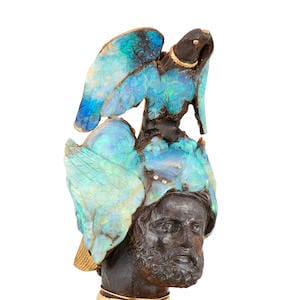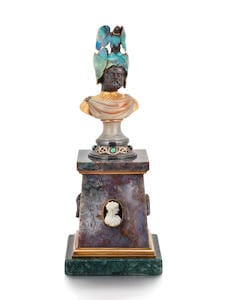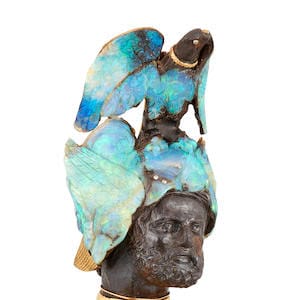
London – Bonhams New Bond Street will be holding its London Jewels sale on 1 December, featuring an exquisite and unique single boulder opal, gemstone and hardstone bust of the Roman god, Mars, by gifted Victorian cameo engraver Wilhelm Schmidt (1845-1938). It was believed Schmidt never signed his work and the one on offer is the only fully signed piece known to exist, Schmidt himself, regarded it as one of his most important and exceptional works. Offered with an estimate of £70,000-100,000.
Wilhelm Schmidt was born in Idar-Oberstein, the European centre of the mineral, gemstone, and lapidary trades. Aged 15, he served as an apprentice to cameo-cutter, Arsène in Paris, who trained him in the neo-classical tradition. Schmidt later settled in London where he set up an engraving business in Hatton Garden, trading alongside his gem-dealing brother Louis. Schmidt went on to carve cameos from unusual materials such as labradorite, malachite, tourmaline, crocidolite, moonstone, zircon, tourmaline, malachite, lapis lazuli, sapphire, amethyst, topaz and, most unusual of all, opal that was to become his trademark. He sold his work for use in ornamental jewels produced by prestigious jewellery firms such as John Brodgen, Tiffany & Co., Child & Child, Giuliano, and Marcus & Co. These carvings were unsigned, and the retailers did not credit Schmidt in their finished jewels.

Emily Barber, Bonhams Head of Jewellery, UK, commented: “Opals are perilous to carve. Formed from hardened silica gel with an unusually high-water content, they can crack and spoil if the temperature conditions fluctuate or if handled by unskilled hands. It is even more astounding to realise that Schmidt, who was able to work this fragile gem with such dexterity, sensitivity, and delicacy, did so using only rudimentary, manually operated equipment and with the use of only one good eye.”
The bust on offer, dates from circa 1890, is a highly important signed opal carving depicting the Roman god Mars wearing an Ajax helmet surmounted by a vulture. The bust is sculpted from a single boulder opal, a pioneering technique which Schmidt invented in 1874, a scale of ambition setting it apart from his other known works. The bust is a uniquely important example of Schmidt’s opal carving technique depicting Mars’ bearded face, neck and vulture carved in the dark brown ironstone matrix which resembles deeply patinated bronze. The winged helmet and the vulture’s plumage are highlighted by utilising the thin layers of precious opal within the single boulder and backed in gold, while the torso is covered in delicate chased gold armour with the helmet and vulture’s eyes inlaid with brilliant-cut diamonds. The opal boulder is mounted on a gem-set agate pedestal featuring four cameos on each side.
Wilhelm Schmidt’s great-grandson comments: “It was a joy to see the carving of Mars by my great-grandfather at Bonhams. From the first glimpse it felt familiar, so totally typical of his style and yet of a different order of magnitude. I had never seen a work by him on this scale with this level of intricacy before. I had the pleasure of living with his crystal bust of Christ, now in the V&A Museum, and thought that it was his ‘magnum opus’; it was so highly regarded that it he was granted the Freedom of the City of London of which he was intensely proud. This piece, however, seems to far surpass that masterpiece. The craftsmanship is quite remarkable, especially when you consider that there were no power tools and that he worked with only one eye. There is a spirituality that emanates from the opal, particularly in the three cameo goddesses of the pedestal. Then, in contrast, there is a powerful sense of character and battle-worn experience in the carving of the face of Mars. As his great-grandson, I could not be prouder!”
